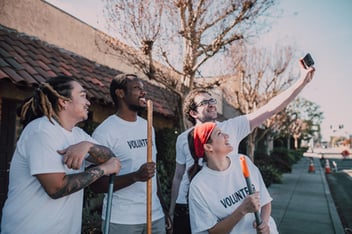Volunteering as a family can be a dynamic, enriching experience for adults and children alike, and more families are looking toward volunteering as a way to spend time together. Read on to learn the benefits of volunteering together and the best opportunities for families:
The Benefits of Volunteering as a Family
There are many reasons to get involved; from improved health to better quality time, your family will benefit from volunteering together while strengthening your community:
Volunteering Transmits Values
Children learn through observation and model this behavior. When parents or other family members exhibit compassionate behaviors, even young children learn that compassion is a behavior with positive consequences. Volunteering with your children teaches other values that parents and guardians work so diligently to instill–values such as selflessness, responsibility, and gratitude.
No Need for a Sitter
You find yourself with that rare free weekend . . . now, what do you do with the kids? Hiring a sitter for just a few hours away can be a hassle (and quite expensive). Why not volunteer—and bring the kids along? Many nonprofits are working to make their opportunities more family-friendly so that everyone can get involved. Plus, volunteering as a family is free! It’s one of the best, cheapest ways to keep the family engaged and active while making a positive difference in the community!
Spend Meaningful Time Together
Families are busier than ever, but they still want to carve out time to be together. When you volunteer with your child–or any family member–you strengthen family bonds, all while making a difference in the community. Ask your family about what causes are important to them. Encourage your children to learn more about the cause. Families who talk about compassion and service will help children understand why the work they’re doing is important to others. Additionally, having a conversation about volunteerism will help ensure the children are prepared for and engaged in the experience.
Learning Beyond the Classroom
Volunteering helps children to develop interpersonal skills and essential habits like leadership and teamwork. It’s also an opportunity to support the learning that happens in school. For example, your community’s park restoration program can enhance this year’s environmental science curriculum. Whether your child simply learns a new skill like gardening, or develops a deeper understanding of food insecurity, volunteering is an opportunity to supplement in-classroom learning.
A Fun Day Out
In addition to the developmental and psychological value that volunteering with your kids provides, we think volunteering can be lots of fun–a benefit that should not be overlooked! Helping out in a proactive way can make for a powerful bonding experience and a perfect feel-good Saturday. Chances are, the kids just may want to volunteer again!
Volunteering for Families: The Best Activities
Many families want to volunteer, but don’t know where to look for volunteer activities that will appeal to the entire family. Many community volunteer centers have easy-to-use volunteer websites that simplify locating and registering for family-appropriate opportunities. We suggest involving children in the selection process and invite conversation about the types of causes they’re interested in. We have compiled a list of opportunities to help inspire your next family volunteering experience:
Help the Elderly
It may seem that your options for volunteering with young children are limited. But young children make for great volunteers by just being themselves! Consider looking for programs that help fight loneliness and bring joy to others, like visiting your local nursing home. Children can learn to connect with people of all ages while bringing joy and reducing feelings of loneliness in the elderly.When children help others, like the elderly, they’re less likely to hold on to negative stereotypes and associations. Consider preparing your children with a thoughtful discussion about the volunteer work. Ask questions like, “What can we learn from older adults?”, or invite young children to speak openly about their thoughts and feelings, and reflect on how their thoughts changed after the experience.
Make Cards for Hospitalized Children
First and foremost, the purpose of volunteering is to serve others. But volunteering experiences for children and their families should also be about growing empathy, a key “internal motivator” to inspire the next generation of thoughtful changemakers. If your children are new to volunteering, or your children are young, you may way to start with simple, but powerful acts of kindness. Making cards for hospitalized children, veterans, the elderly, or anyone who needs a bit of extra love, is a great way to practice empathy. Children will express words of kindness and think about situations other than their own.
Prepare and Serve Meals
There are plenty of jobs to go around for all ages when preparing meals for the hungry. It’s engaging work, and your children can learn new skills. You’ll introduce children and teenagers to complex issues as children interact with those who face challenges other than their own. Volunteering as a family teaches compassion through real-world practice and dispels stereotypes from an early age.
Get Outside
Outdoor activities like park clean up or tree planting provide entertainment for family members of all ages. Opportunities like these offer plenty of tasks for all skill levels, and they’re great for those with youthful energy. You’ll help to beautify public spaces while enjoying a much-needed day off the couch!
Raise Young Activists
Today’s youth are true activists, inspiring incredible and necessary change. They have the creativity and flexibility to understand pressing issues like the climate crisis, and inspire others to take action, too. Small acts, when accomplished together, have greater impact on our communities. So look for local walks for causes where friends and family can share their voices and follow in the footsteps of important leaders. Just be sure to check that the walk, march, or event is well-organized at an official capacity, child-friendly, and safe for young ones.
Volunteer Vacations for Families
Many families are looking for ways to give back while visiting somewhere new. Volunteer vacations, also referred to as “voluntourism,” is an emerging trend that’s also associated with its share of controversy; many experts wonder if it does more harm than good for communities visited. It is possible to go on vacation and instill family values, so we’ve put together some tips to choose an ethical family volunteer vacation:
How to Choose Ethical Volunteer Vacations for Families 2019 and 2020
We’re on the lookout for volunteer vacations that offer responsible, respectful immersive learning experiences for families.
Work Alongside Communities
Because volunteering vacations require participants to pay, it’s tempting for communities to encourage voluntourism to help meet local needs, rather than pay community members fair wages to complete the same task. So, your free labor may actual replace a community member’s paying job. There are, however, ethical tourism companies, like People and Places, that ensure you’re working “with community members and not instead of them.” Keep in mind that the price of the trip does not necessarily indicate level of ethicalness. Your travel company should be transparent about where the money you pay goes, including the percentage that is put back into the community. There are plenty of affordable family volunteer vacations that are just as rewarding as pricier options.
Opt for Conservation
Most volunteering family vacations are short-term and non-recurring, which can be more detrimental than helpful to some communities, depending on the project. According to this article’s guidelines, conservation efforts make for appropriate family volunteering vacations because “the impact on the animals or biodiversity does not depend on developing personal relationships.” Working with children abroad is a popular choice among travelling volunteers. While seeing the smiles of children can be immensely rewarding, “an endless stream of visitors can be psychologically disruptive to children.” It is recommended that tourists avoid working at orphanages, as studies show these institutions are an ineffective solution to child homelessness. Needless to say, it’s important that volunteers put the needs of the community before their own, and consider family volunteer opportunities that truly help those in need.
Family volunteer vacations with animals can be a fun way to instill empathy and create lasting memories. The Best Friends Animal Sanctuary in Utah involves children ages 6 and up, so even your little ones can get involved. Children and teenagers can work with each other at their kids summer camp, or volunteer alongside their parents to help care for homeless animals.
For the budding ecologists in your family, choose a family volunteer vacation set outdoors. Located in one California’s breathtaking Sequoia National Park, Nature Corps offers a 5-day camping, conservation adventure. Children and adults work to support the park’s conservation efforts, while enjoying fun group meals and hiking trips in between. You’ll make friends, learn about protecting our nation’s environment, and take in the grandeur of the world’s tallest trees.
Learn and Reflect
Generally, we recommend searching for an organization that provides your family with the information to make an informed decision as a family. Consider exploring the cultural, political, and economic histories of the communities you’re visiting. And above all, “voluntourism” should facilitate respect and understanding about other ways of life, and inform future decisions you make as a family.





